Are you looking for a game-changing strategy to boost your website’s visibility? Look no further than topic clusters. This revolutionary concept in content organization and optimization can take your online presence to new heights.
By grouping related content together, topic clusters help search engines understand the context of your website, leading to improved rankings.
The secret lies in the topic cluster model, which comprises a pillar page and subtopic pages that link back to it. Not only does this enhance the user experience by providing relevant information in one place, but it also encourages visitors to explore more of your site.
With topic clusters, you can create an engaging web of interconnected ideas and drive organic traffic like never before.
Let’s dive into the world of topic clusters and unlock endless possibilities for your online success!
- What is the Topic Cluster Model in SEO?
- Understanding Search Engine Optimization in Relation to Topic Clusters
- Utilizing Topic Clusters to Increase Authority
- How Topic Clusters Work: Muscle and Strength’s Workout Database Example
- Examples of Topic Clusters: Quickmail’s Cold Email Knowledge Base
- Choosing a Core Topic for Your Cluster
- Conducting Keyword Research for Topic Clusters
- Adapting Your Website Structure for Topic Clusters
- Improving User Experience with Topic Clusters
- The Importance of Quality Content in Topic Clusters
- Measuring Results and Boosting Traffic with Topic Clusters
- Building a Topic Cluster: 5 Key Elements
- Measuring the Results of Your Topic Cluster Strategy
- Additional FAQs on Topic Cluster
- Conclusion: The Power and Potential of Topic Clusters
What is the Topic Cluster Model in SEO?
The topic cluster model is an innovative SEO strategy that has gained popularity in recent years. It revolves around creating interconnected content centered on a core topic, which helps improve search engine optimization and boost organic traffic.
At its core, the topic cluster model involves linking subtopic pages to a central pillar page. This interlinking signals relevance to search engines, indicating that your website provides comprehensive and valuable information on a particular subject.
By organizing your content this way, you are telling search engines that you have in-depth expertise and knowledge on the topic.
Implementing topic clusters can have significant benefits for your website’s visibility and rankings. Here’s why:
- Improved Content Relevance: By grouping related content together under a central pillar page, you establish clear connections between different aspects of a topic. This allows search engines to understand the depth of your expertise and relevance, making it more likely for your website to appear in relevant search results.
- Enhanced User Experience: Topic clusters make it easier for users to navigate through your website and find relevant information. When visitors land on one of your subtopic pages, they can easily explore related content by following links within the cluster. This improves user experience and encourages them to spend more time on your site.
- Keyword Targeting: Each subtopic page within a topic cluster focuses on specific keywords related to the overarching core topic. By optimizing these pages for targeted keywords, you increase the chances of ranking well for those terms in search engine results pages (SERPs).
- Authority Building: Creating comprehensive content around a core topic establishes your website as an authority in that field. As users engage with multiple pieces of high-quality content within your topic cluster, they develop trust in your expertise. They are more likely to return to your site for future information needs.
To implement the topic cluster model effectively, consider these tips:
- Research and identify a core topic that aligns with your website’s niche and target audience.
- Create a central pillar page that provides an overview of the core topic and links to relevant subtopic pages.
- Develop high-quality content for each subtopic page, ensuring they cover different aspects or angles related to the core topic.
- Optimize each subtopic page for specific keywords while maintaining cohesion within the cluster.
- Interlink the subtopic pages with anchor text that reflects their relationship to the central pillar page.
- Regularly update and expand your topic cluster by adding new subtopics or updating existing content.
Understanding Search Engine Optimization in Relation to Topic Clusters
Topic clusters organize content hierarchically around a central pillar page covering an overarching topic.
Subtopic pages then delve into specific aspects related to the main topic, creating a comprehensive resource for users.
This hierarchical structure improves the internal linking within a website and enhances its visibility on search engines.
Google and other search engines prioritize websites that provide comprehensive information on specific topics.
By utilizing topic clusters, businesses can create valuable resources that cover various aspects of a subject matter. This increases the chances of ranking higher in SERPs as search engines recognize the relevance and depth of the content provided.
Optimizing individual subtopic pages within a cluster plays a vital role in enhancing their visibility and driving organic traffic. Each subtopic page should be optimized using relevant keywords and meta tags to ensure it ranks well on search engine result pages.
Internal links should be strategically placed throughout the cluster to guide users from one page to another while signaling their importance to search engines.
An essential element of topic clusters is the pillar page, which serves as the central hub for all related subtopics. The pillar page provides an overview of the main topic and links out to individual subtopic pages for detailed information. It acts as an authority piece that attracts external backlinks, further boosting its credibility and improving its ranking potential.
To fully leverage topic clusters for SEO purposes, businesses must conduct thorough keyword research targeting long-tail keywords specific to each subtopic and broader keywords related to the overarching theme.
By incorporating these keywords naturally into the content, businesses can increase their chances of ranking for a wide range of search queries.
Utilizing Topic Clusters to Increase Authority
Building topic clusters effectively establishes your website as an authoritative source within your niche or industry.
By organizing your content around a central pillar page and interlinking relevant subtopics, you can strengthen the authority signals that search engines look for.
Search engines consider websites that cover a wide range of related topics as more credible and trustworthy. Creating a pillar page covering the main topic comprehensively provides a solid foundation for building authority. This pillar page acts as the hub of information where users can find all the essential details about the topic.
To further enhance this authority, you need to create subtopic pages that delve into specific aspects of the main topic.
Each subtopic should be linked back to the pillar page, forming a cluster of interconnected content.
This interlinking structure helps search engines understand the relationship between different pieces of content and reinforces the authority signals of the pillar page.
As users explore various subtopic pages within your cluster, they spend more time on your site. This extended dwell time sends positive signals to search engines, indicating that users find value in your content and are engaging with it.
The longer users stay on your site and navigate through its pages, the stronger their perception of your expertise becomes.
By increasing topical authority through topic clusters, you can expect several benefits for your website. First and foremost, improved organic rankings are likely as search engines recognize your site’s comprehensive coverage of relevant topics.
Higher rankings lead to increased visibility in search results, driving more organic traffic to your website.
As users spend more time exploring different subtopics within your cluster, they develop trust in your brand’s expertise.
This enhanced brand reputation increases user loyalty and attracts new visitors seeking reliable information in your niche or industry.
How Topic Clusters Work: Muscle and Strength’s Workout Database Example
Muscle and Strength’s workout database is a prime example of how topic clusters can be effectively implemented. By understanding the structure and functionality of their website, we can gain insight into the benefits of utilizing topic clusters in content organization.
The pillar page on Muscle and Strength’s website focuses on a broad topic: “workout routines.” This serves as the central hub for all related subtopic pages. These subtopic pages cover specific exercises or muscle groups, providing detailed information and guidance to users.
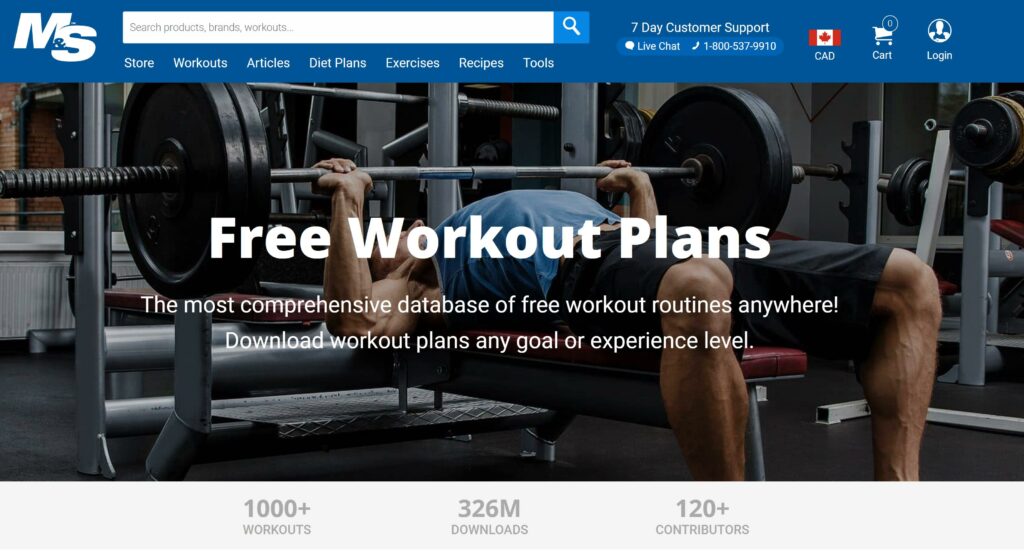
One of the key advantages of this approach is the hierarchical structure it creates. Each subtopic page links back to the pillar page, establishing a clear connection between them. This signals relevance to search engines, which helps improve organic visibility. This interlinking allows users to easily navigate between related content, enhancing their overall experience on the site.
For instance, if a user is interested in finding exercises targeting their chest muscles, they can simply click on the “Chest Workouts” subtopic page from the pillar page.

From there, they will find various workouts specifically designed for chest development with detailed instructions and videos. The user can then navigate back to the pillar page or explore other subtopics, such as “Leg Workouts” or “Back Exercises,” depending on their interests.
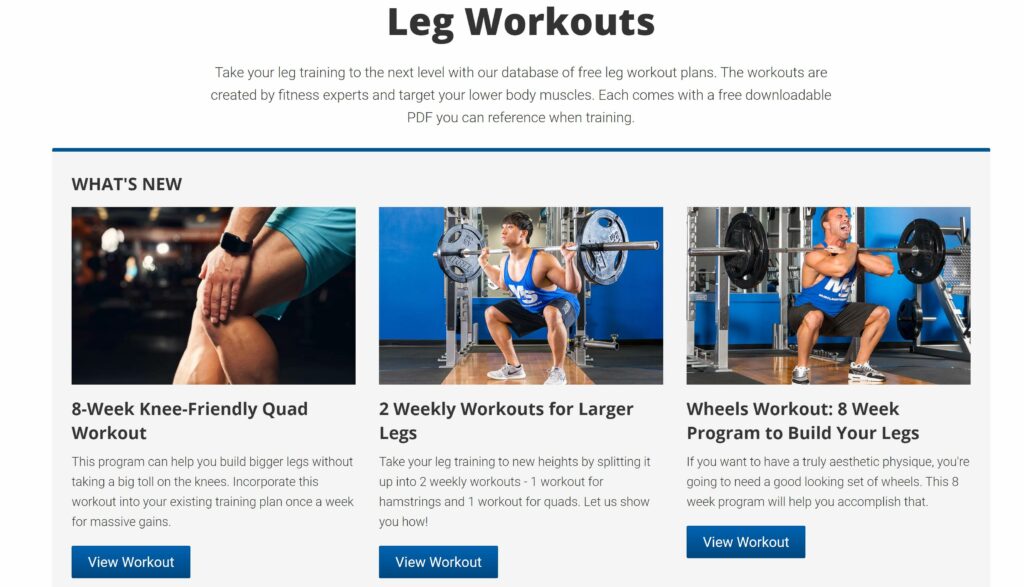
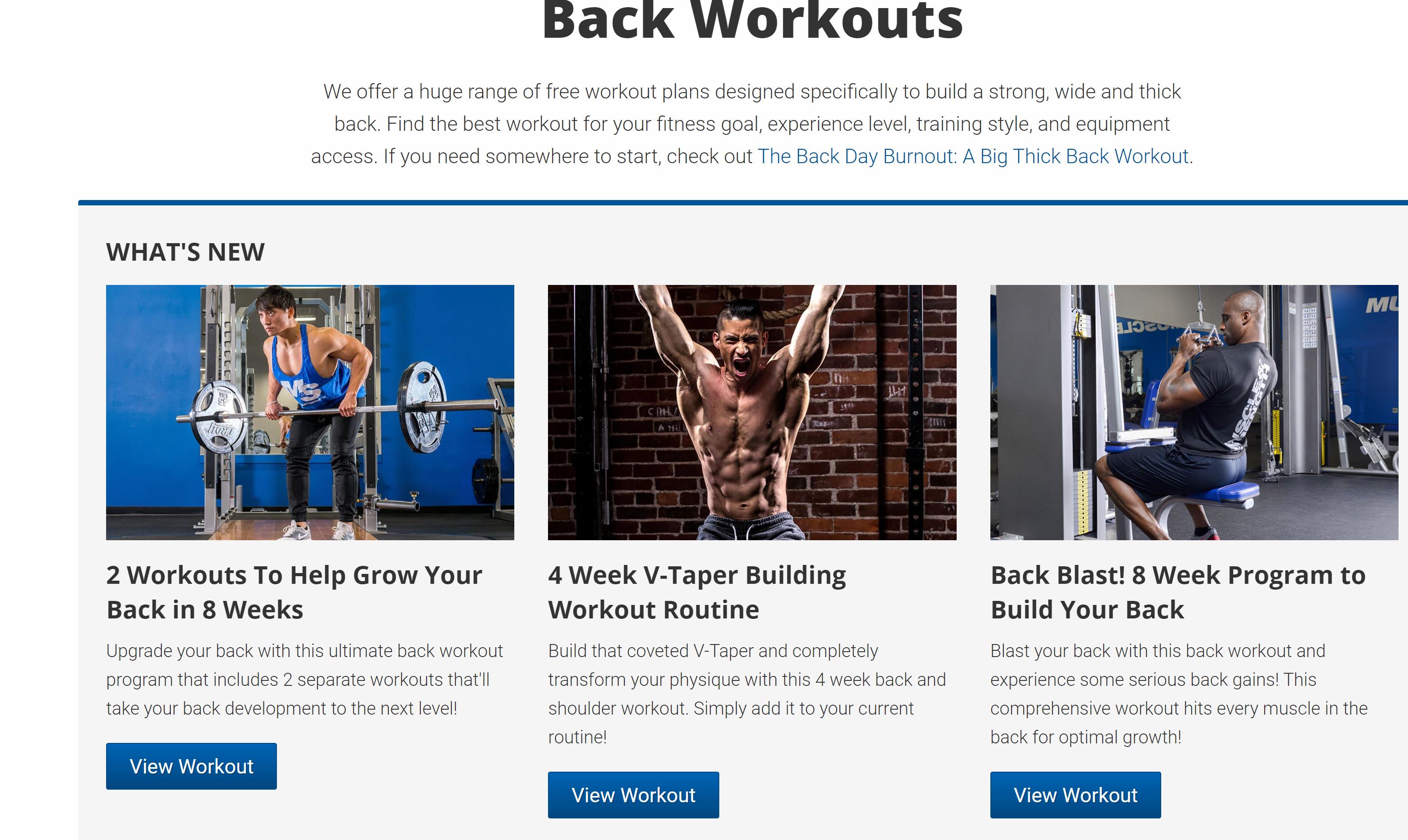
By organizing content in this manner, Muscle and Strength’s workout database ensures that users have access to comprehensive information while keeping them engaged with related topics. This encourages users to spend more time exploring different aspects of fitness within their website.
Furthermore, employing topic clusters helps establish authority in a particular niche or industry.
As search engines recognize the interconnectedness of these pages through internal linking structures, they perceive the website as an authoritative source for fitness-related topics. This can lead to improved rankings for relevant keywords and increased organic traffic over time.
Examples of Topic Clusters: Quickmail’s Cold Email Knowledge Base
Quickmail’s Cold Email Guide is an excellent example of effectively implementing topic clusters. By employing this strategy, Quickmail has created a comprehensive resource that covers various aspects of cold email marketing while maintaining a cohesive structure.
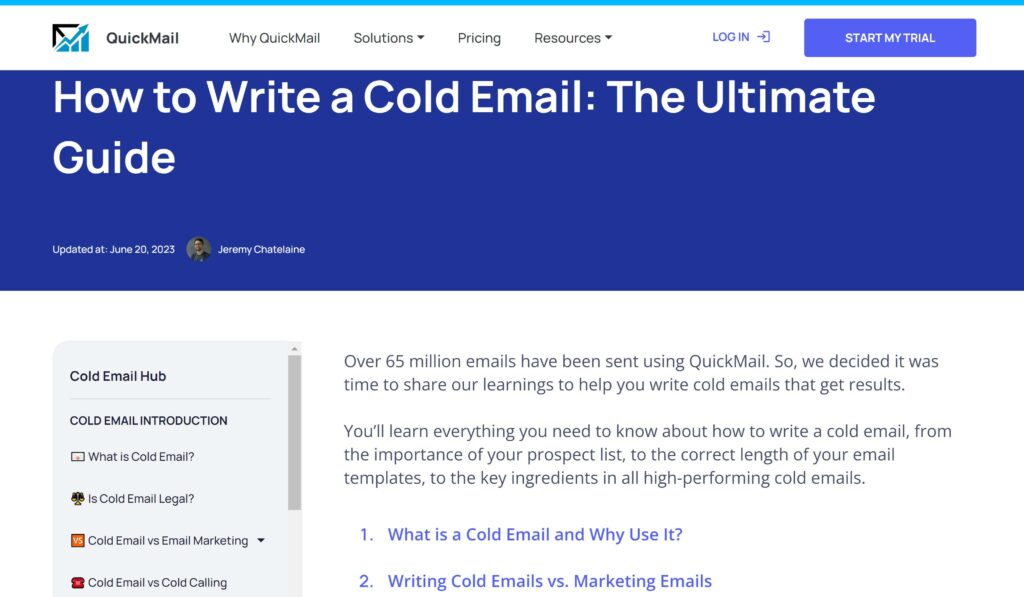
The pillar page of the knowledge base focuses on the broad topic of “cold email.” It provides an overview and introduction to the concept, catering to users who may be new to this marketing approach. This pillar page acts as a central hub, connecting all subtopic pages within the cluster.
Within Quickmail’s Guide, there are several subtopic pages that delve into specific areas related to cold email. These subtopics include subject lines, templates, follow-ups, and more. Each subtopic page is linked back to the pillar page, creating a network of interconnected content.
This interlinking between the pillar page and its subtopics is crucial for search engine optimization. It signals to search engines like Google that these pages are relevant and valuable sources of information on cold email strategies.
As a result, Quickmail’s Cold Email Guide has a higher chance of appearing in search results when users seek information about cold emailing.
One major advantage of this topic cluster strategy is that it allows users to easily navigate between related topics within the knowledge base.
For instance, if someone wants to learn about effective subject lines for cold emails after reading about general cold email strategies on the pillar page, they can simply click on the subject lines subtopic link. This seamless navigation enhances user experience and ensures they find comprehensive information without having to search elsewhere.
Moreover, by structuring its knowledge base as a topic cluster, Quickmail addresses common questions and concerns that users may have about cold email marketing. The various subtopics cover different aspects that address these queries comprehensively.
In addition to serving as a valuable resource for readers interested in inbound marketing techniques like cold emailing, Quickmail’s cold emailing guide also demonstrates its expertise in the field. By providing detailed and informative content, they establish themselves as a trusted source of information.
Quickmail’s Cold Email Guide is an excellent example of creating a topic cluster that caters to users’ needs while signaling relevance to search engines. It showcases the power of organizing content around a central pillar page and interlinking related subtopics.
By following this strategy, businesses can create comprehensive resources that provide valuable information to their audience while boosting their online visibility.
Choosing a Core Topic for Your Cluster
Selecting an appropriate core topic is crucial for building an effective topic cluster strategy.
The core topic acts as the central theme around which all subtopics revolve, providing a structure that enhances your website’s visibility and authority on search engines.
To ensure the success of your topic cluster, consider the following talking points:
Broad Yet Specific
The core topic should strike a balance between being broad enough to encompass multiple subtopics and specific enough to target a particular audience. It should reflect the overarching theme of your content while allowing for in-depth exploration within each related piece.
For example, if you have a fitness blog, choosing “weight loss” as your core topic would be too generic. Instead, opt for something more specific like “high-intensity interval training (HIIT) workouts for weight loss.” This specificity helps attract an audience interested in that specific subject.
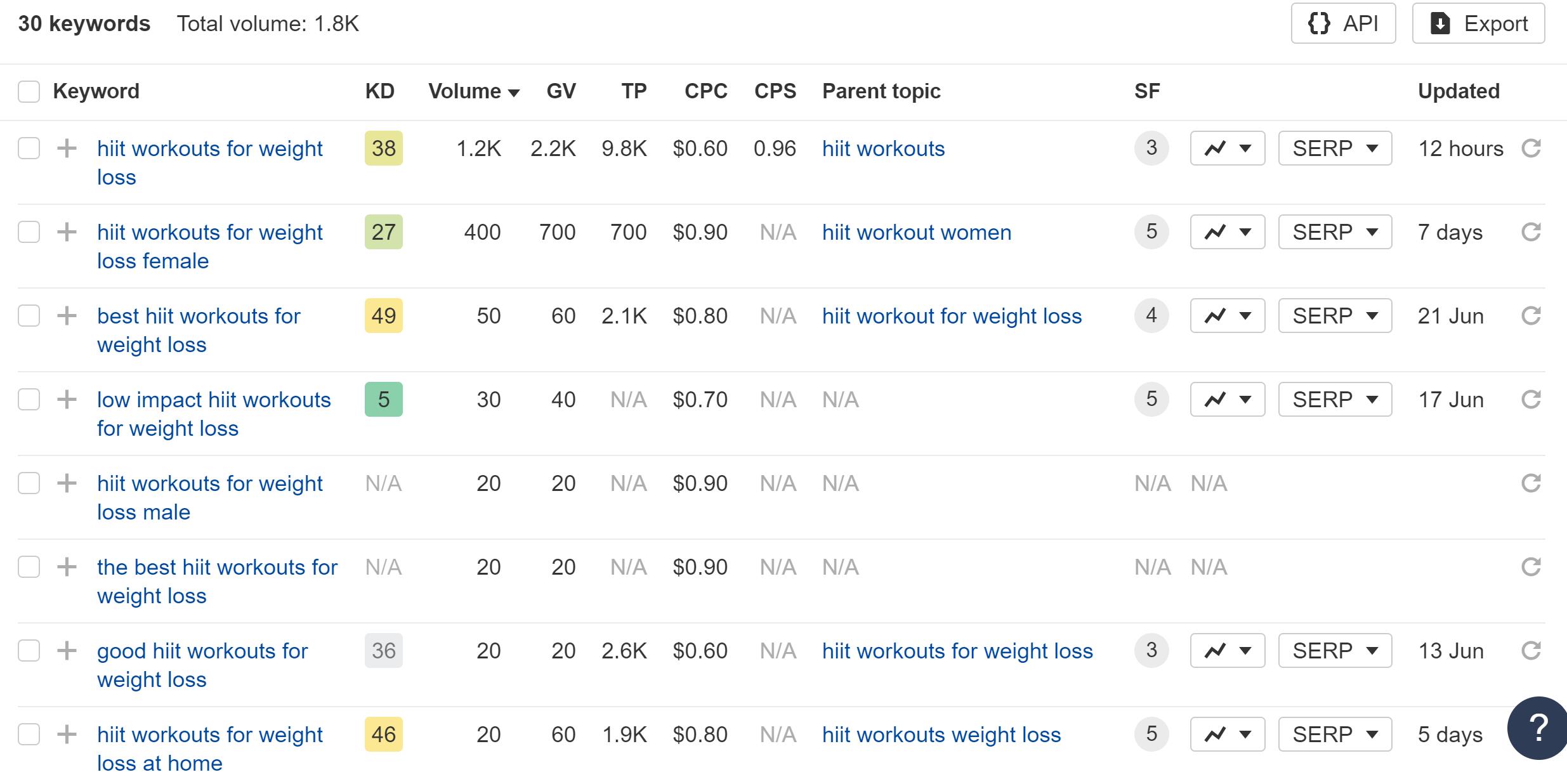
Consider Your Target Audience
Understanding your target audience is essential when selecting a core topic. Consider their interests, preferences, and search intent.
By aligning your content with what they are actively searching for or interested in, you increase the chances of attracting relevant traffic to your website.
Analyze their demographics and psychographics to identify topics that resonate with them.
Relevance to Your Business or Website
While it’s important to cater to your audience’s interests, don’t forget about the relevance of the chosen core topic to your business or website.
Ensure that it aligns with your brand identity and objectives.
If you run an e-commerce store selling organic skincare products, a suitable core topic could be “natural skincare routines.” This choice not only attracts potential customers but also establishes you as an authority in the field.
Keyword Research and Competitor Analysis
To identify potential core topics, conduct thorough keyword research and competitor analysis.
Look for keywords related to your industry or niche with high search volume but low competition.
Tools like Google Keyword Planner, SEMrush, or Ahrefs can assist in finding relevant keywords and assessing their competitiveness.
Analyze your competitors’ content strategies to identify gaps and opportunities for differentiation.
Following these guidelines, you can select a core topic that forms the foundation of an effective topic cluster strategy.
Remember to choose a broad yet specific subject that aligns with your target audience’s interests and search intent while remaining relevant to your business or website.
Conduct comprehensive keyword research and competitor analysis to ensure you’re targeting topics with high search volume and low competition.
With a well-chosen core topic, you can build a robust cluster of interlinked content that enhances your online visibility and authority.
Conducting Keyword Research for Topic Clusters
One of the most crucial aspects of content optimization is thoroughly researching relevant keywords and related phrases. By conducting proper keyword research, you increase the visibility of your content in search engine results.
Here are some key points to consider when conducting keyword research for topic clusters:
Identify Relevant Keywords and Phrases
The first step in conducting keyword research is to identify keywords and phrases that are closely related to your core topic.
These keywords will help you understand what users are searching for when they look for information on your subject matter.
Utilize tools like Google Keyword Planner, SEMrush, or Ahrefs to find relevant keywords with high search volume and low competition. These tools provide valuable insights into the popularity of specific keywords and help you gauge their competitiveness.
Focus on Long-Tail Keywords
When building a topic cluster, it’s important to focus on long-tail keywords that align with your subtopic pages within the cluster.
Long-tail keywords are more specific and have lower search volume compared to generic terms. However, they often have higher conversion rates as they accurately reflect the searcher’s intent.
For example, if your main topic is “recruiting,” some long-tail keywords could be “best recruiting strategies,” “how to recruit top talent,” or “recruiting techniques for startups.” Incorporating these long-tail keywords throughout your content will attract more targeted traffic.
Incorporate Variations Naturally
While focusing on specific long-tail keywords, it’s also essential to incorporate variations of these keywords naturally throughout your content. This helps search engines understand the context of your content and improves its relevance.
For instance, if one of your target long-tail keywords is “key recruitment strategies,” you can include variations like “effective recruitment methods” or “strategies for successful hiring.”
By using synonyms and related terms, you expand the reach of your content and cater to a broader audience.
Consider Search Volume and Competition
When selecting keywords, consider both their search volume and competition.
High search volume indicates that many users are searching for that particular keyword or phrase, while low competition suggests that fewer websites are targeting it.
Finding the right balance between search volume and competition is crucial.
Targeting highly competitive keywords might be challenging for new websites, so focusing on less competitive alternatives with decent search volume is often beneficial. This strategy allows you to rank higher in search results and attract more organic traffic.
Adapting Your Website Structure for Topic Clusters
Adapting your website structure is crucial for enhancing the overall user experience and improving search engine optimization.
Organizing content into pillar and subtopic pages within a topic cluster allows you to create a clear hierarchy that helps users and search engines navigate your website effectively.
To begin with, pillar pages serve as the central hub of information for a specific topic. These pages cover broad aspects of the subject matter and provide comprehensive insights. They act as an anchor point for all related subtopic pages within the cluster.
By linking all relevant subtopic pages back to the central pillar page, you establish a strong internal linking structure that signals to search engines the importance of each page in relation to the main topic.
Optimizing internal linking is essential when adapting your website structure. You should use descriptive anchor text that includes targeted keywords to give users and search engines a clear understanding of what they can expect when clicking on a link.
For example, instead of using generic terms like “click here,” use specific phrases like “learn more about [targeted keyword].” This not only improves navigation but also reinforces the relevance of each page within the topic cluster.
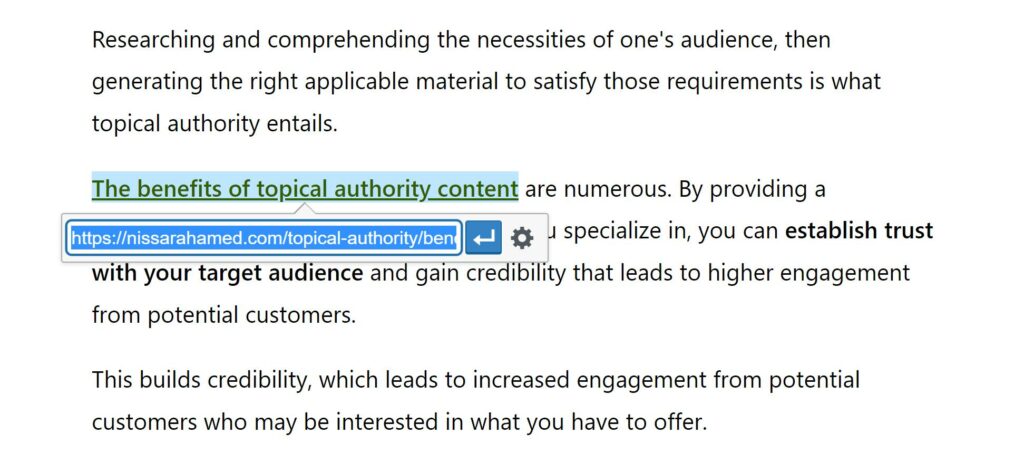
Incorporating menus or sidebar links that lead to different sections of the cluster is another way to ensure easy navigation for users.
By providing these navigational elements, visitors can quickly jump between various subtopics or explore different aspects of your content without getting lost. This enhances their overall browsing experience and encourages them to spend more time on your website.
When structuring your website around topic clusters, it’s important to consider how many pages will be included in each cluster.
While having many pages covering different angles and perspectives is beneficial, you should avoid creating excessive duplication or thin content across multiple subtopics.
Each page within a cluster should offer unique insights or focus on specific aspects related to the main topic.
Improving User Experience with Topic Clusters
Topic clusters are a powerful tool for enhancing user experience on your website.
By providing comprehensive information on specific topics of interest, topic clusters allow users to easily navigate between related content, find answers to their queries more efficiently, and ultimately have a more satisfying customer journey.
One of the key benefits of topic clusters is that they improve the site structure. With well-designed clusters, you can create a logical organization of content that makes it easier for users to explore different sections of your website.
Instead of searching through multiple pages or using complex navigation menus, users can simply follow the links within a cluster to access relevant information. This streamlined approach saves time and effort, resulting in a smoother user experience.
Another advantage of topic clusters is their ability to keep users engaged. By offering valuable content in an organized manner, you can encourage visitors to spend more time on your site.
Users who find all the information they need within a single cluster are less likely to bounce off your page and seek answers elsewhere. This increased engagement improves user satisfaction and has positive implications for search engine optimization (SEO), as longer session durations signal quality content.
To illustrate the impact of topic clusters on user experience, consider an agile software development company that offers various services.
Creating a topic cluster around the keyword “agile” can provide comprehensive resources such as articles, case studies, and tutorials related to agile methodologies. Users interested in learning about agile practices will find everything they need within this cluster, eliminating the need for extensive searching across multiple pages.
Furthermore, topic clusters enable you to address different stages of the customer journey effectively. Organizing content based on specific topics rather than individual keywords or phrases allows you to cater to users at different stages of their buying process.
For example, someone in the early research phase may seek general information about agile methodologies. At the same time, another person in the decision-making process may seek specific services related to agile implementation.
With topic clusters, you can provide tailored content for each stage, ensuring a seamless user experience throughout the customer journey.
The Importance of Quality Content in Topic Clusters
High-quality content is crucial for the success of topic clusters as it attracts and engages users while establishing authority in your niche.
The goal is to provide comprehensive information on a specific topic by linking related content together.
Creating a network of interconnected content can enhance the user experience and improve your website’s visibility in search engine results.
Each subtopic page should provide valuable, in-depth information that satisfies user search intent. This means going beyond surface-level explanations and diving deep into the subject matter.
Users are looking for detailed insights and practical advice, so ensure your content meets these expectations.
Consider including step-by-step instructions, case studies, or real-life examples to provide tangible value to your audience.
Incorporate multimedia elements like images, videos, or infographics to enhance your content’s visual appeal and comprehensibility.
Visuals break up text-heavy pages and help convey complex concepts more effectively.
For example, if you’re explaining a process or showcasing data trends, using an infographic can make it easier for readers to grasp the information at a glance.
Regularly update and refresh your content to ensure it remains relevant and up-to-date. In today’s fast-paced digital landscape, information becomes outdated quickly.
Regularly reviewing and updating your content cluster demonstrates that you are committed to providing accurate and current information to your audience.
Search engines favor fresh content when determining rankings, so keeping your cluster up-to-date can also have SEO benefits.
Remember, handpicked related content is key in establishing yourself as an authority in your niche and driving organic traffic to your website. So invest time and effort into developing a solid content marketing strategy centered around topic clusters.
Measuring Results and Boosting Traffic with Topic Clusters
Tracking key metrics such as organic traffic, time on page, bounce rate, and conversions is crucial to measuring the success of your topic clusters. By analyzing these metrics, you can gain insights into how well your content is performing and identify areas for improvement in your cluster strategy.
To effectively measure the results of your topic clusters, leverage analytics tools like Google Analytics or SEO platforms. These tools provide valuable data that can help you understand how your target audience interacts with your content.
For example, Google Analytics offers detailed reports on website traffic sources, user behavior, and conversion rates.
Analyzing data from these tools allows you to identify which topics within your cluster are resonating most with your audience. You can then further optimize those high-performing topics while adjusting to underperforming ones.
Regularly updating and optimizing your content based on performance data is essential for increasing traffic and engagement within your topic clusters. This involves refining keywords, improving meta tags, enhancing readability, and incorporating relevant internal links.
By continuously monitoring the performance of each cluster piece and making necessary adjustments, you can ensure that they remain aligned with search engine algorithms and user preferences.
In addition to optimizing individual pieces of content within a cluster, it’s important to consider broader promotional strategies to drive more traffic. Implementing marketing tactics such as social media marketing or email campaigns can significantly boost visibility for your topic clusters.
Social media platforms provide an excellent opportunity to reach a wider audience by sharing engaging snippets from your cluster pieces along with compelling captions or hashtags. Encouraging readers to share this content further expands its reach organically.
Email campaigns offer another effective way to promote topic clusters directly to interested individuals who have subscribed to receive updates from you.
Craft enticing subject lines that pique their curiosity while providing value-driven snippets of information related to the cluster topics. Include clear calls-to-action that direct recipients back to specific cluster pieces on your website.
Combining these promotional strategies with ongoing optimization efforts can maximize the traffic and engagement generated by your topic clusters.
Continuously monitoring analytics data and making data-driven decisions will help you refine your strategy over time, ensuring that your content remains relevant and resonates with your target audience.
Building a Topic Cluster: 5 Key Elements
Selecting a Core Topic
The first step to building an effective topic cluster is to select a core topic that aligns with your target audience’s interests and search intent.
Consider what topics are relevant to your business or industry and what your audience is likely searching for. This core topic will serve as the foundation for your cluster.
Conduct Keyword Research
Once you have chosen a core topic, conducting keyword research is important to identify relevant long-tail keywords for subtopic pages within the cluster.
Long-tail keywords are more specific and less competitive than broad keywords, allowing you to target a niche audience and increase your chances of ranking higher in search engine results.
Create a Pillar Page
The next step in building a topic cluster is creating a pillar page. This page should provide an overview of the core topic and include links to related subtopic pages.
The pillar page acts as the central hub of information for the cluster, making it easier for search engines to understand the relationship between different pages and improving overall SEO.
Develop High-Quality Content
For each subtopic page within the cluster, developing high-quality, informative content that engages readers is essential.
Incorporate targeted keywords naturally throughout the content while ensuring it remains valuable and engaging for your audience.
By providing valuable information on each subtopic, you establish yourself as an authority in your field and improve your chances of ranking higher in search results.
Optimize Internal Linking
To maximize the effectiveness of your topic cluster, optimize internal linking by interlinking all subtopic pages with the pillar page using descriptive anchor text.
This helps search engines understand the structure of your content and improves user experience by guiding visitors through related topics seamlessly.
Measuring the Results of Your Topic Cluster Strategy
To truly gauge the effectiveness of your topic cluster strategy, it’s essential to rely on analytics tools that provide valuable insights.
Platforms like Google Analytics or SEO platforms can help you measure the performance and impact of your efforts. Here are some key metrics to track when evaluating your topic cluster strategy:
Organic Traffic
One of the primary goals of any marketing strategy is to increase organic traffic to your website.
By analyzing organic traffic data, you can determine whether your topic clusters are attracting more visitors from search engines. Look for an upward trend in organic traffic over time as a positive indicator of success.
Rankings
Monitoring keyword rankings is crucial in measuring the visibility and reach of your topic clusters.
Keep an eye on how well your target keywords are performing in search engine results pages (SERPs). Higher rankings indicate that your content is resonating with users and gaining prominence.
Backlinks
Backlinks play a significant role in improving your website’s authority and credibility. Measure the number and quality of backlinks generated by your topic cluster content.
A higher number of relevant backlinks indicates that other reputable websites find value in linking to your content, contributing to its overall success.
Time on Page
Assessing how much time users spend on each page within your topic clusters provides insights into their engagement levels.
Longer average time on the page suggests that visitors find value in the content and are willing to invest their time in consuming it thoroughly.
Bounce Rate
The bounce rate measures the percentage of visitors who leave after viewing only one page.
A high bounce rate may indicate that the content doesn’t meet user expectations or fails to capture their interest effectively. Keeping an eye on this metric helps identify areas for improvement within your topic clusters.
Conversions
Ultimately, conversions are what drive business growth and revenue generation. Track how many visitors from each topic cluster convert into leads or customers. This metric provides a clear indication of the effectiveness of your content in driving desired actions.
By comparing these metrics before and after implementing topic clusters, you can assess the impact on your website’s visibility, engagement levels, and overall marketing strategy.
Analyzing the data will help you identify areas that require improvement or adjustment to continuously enhance your results.
Remember that measuring the results of your topic cluster strategy is an ongoing process.
Regularly monitor these metrics to stay informed about the performance of your content and make data-driven decisions.
By leveraging analytics tools and adjusting your approach based on performance data, you can maximize the benefits of topic clusters for your marketing strategy.
Additional FAQs on Topic Cluster
How Long Does It Take to See Results from Topic Clusters?
The timeline for seeing results from topic clusters may vary depending on several factors, such as the competitiveness of your industry, the quality of your content, and the strength of your website’s existing authority.
Generally, it may take a few months before significant improvements in organic traffic and search rankings become noticeable.
Can I Implement Topic Clusters on An Existing Website?
Absolutely! Topic clusters can be implemented on both new and existing websites. If you already have substantial content, you can start by identifying core topics that align with your existing content pillars.
From there, create pillar pages and interlink relevant subtopics to begin building your cluster structure.
Do I Need to Update My Existing Content to Fit Into the Topic Cluster Model?
While updating existing content is not mandatory for implementing topic clusters, it can be beneficial in enhancing the overall effectiveness of your strategy.
By revisiting older articles or blog posts related to your core topics and optimizing them with internal links to other relevant subtopics within your cluster, you can strengthen the interconnectedness of your content and improve its visibility.
Are There Any Specific Tools Available for Managing Topic Clusters?
Several SEO tools offer features that can assist in managing topic clusters effectively.
These tools provide functionalities like keyword research, content organization, internal linking suggestions, and performance tracking. Some popular options include SEMrush’s Topic Research tool and Ahrefs’ Content Explorer.
Can Topic Clusters Help Improve My Website’s Authority in A Competitive Industry?
Yes, implementing topic clusters can be particularly beneficial in competitive industries.
By focusing on comprehensive coverage of core topics and leveraging internal linking between related subtopics, you can demonstrate expertise and authority to both users and search engines.
Over time, this approach can contribute to improving your website’s authority and visibility within your industry.
Conclusion: The Power and Potential of Topic Clusters
In conclusion, topic clusters have emerged as a powerful search engine optimization (SEO) strategy to boost website authority, improve user experience, and increase organic traffic.
By organizing content around a core topic and linking related subtopics together, websites can enhance their visibility on search engine result pages (SERPs) and provide valuable information to users.
Utilizing the topic cluster model allows websites to establish themselves as authoritative sources in their respective industries.
By creating comprehensive content that covers various aspects of a specific topic, websites can demonstrate expertise, build trust with their audience, and attract high-quality backlinks from other reputable sites. This approach aligns with Google’s E-A-T concept, emphasizing expertise, authoritativeness, and trustworthiness.
Choosing the right core topic for your cluster is crucial. It should be broad enough to encompass multiple subtopics but specific enough to target your desired audience effectively.
Conducting thorough keyword research will help identify relevant subtopics that can be linked back to the core topic, ensuring comprehensive coverage of the subject matter.
Adapting your website structure to accommodate topic clusters is essential for effective implementation.
Creating pillar pages that serve as hubs for each core topic allows for easy navigation between related subtopics. This internal linking structure enhances user experience by providing a logical flow of information while signaling search engines about the interconnectedness of the content.
Measuring the results of your topic cluster strategy is vital to evaluate its effectiveness and make necessary adjustments.
Monitoring organic traffic growth, engagement metrics such as time on page and bounce rate, as well as conversions driven by the cluster content, provides insights into its impact on your website’s performance.
By implementing topic clusters, websites can improve their search engine rankings and enhance the user experience by providing valuable and organized information. The power and potential of topic clusters lie in their ability to establish authority, increase organic traffic, and ultimately drive business growth.
